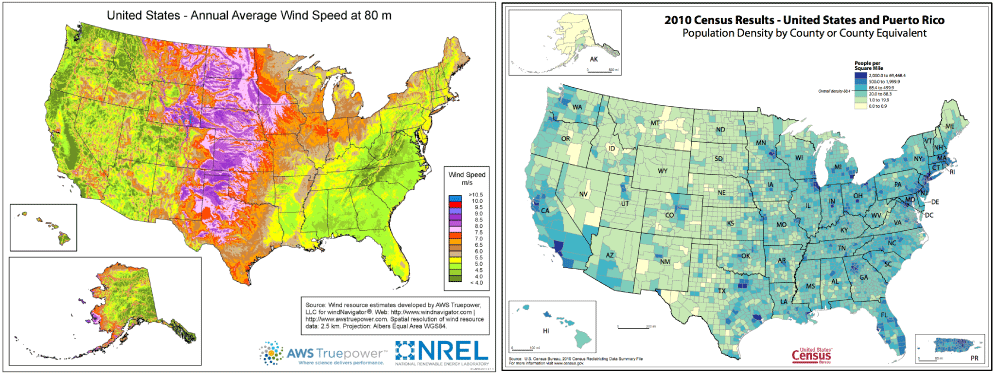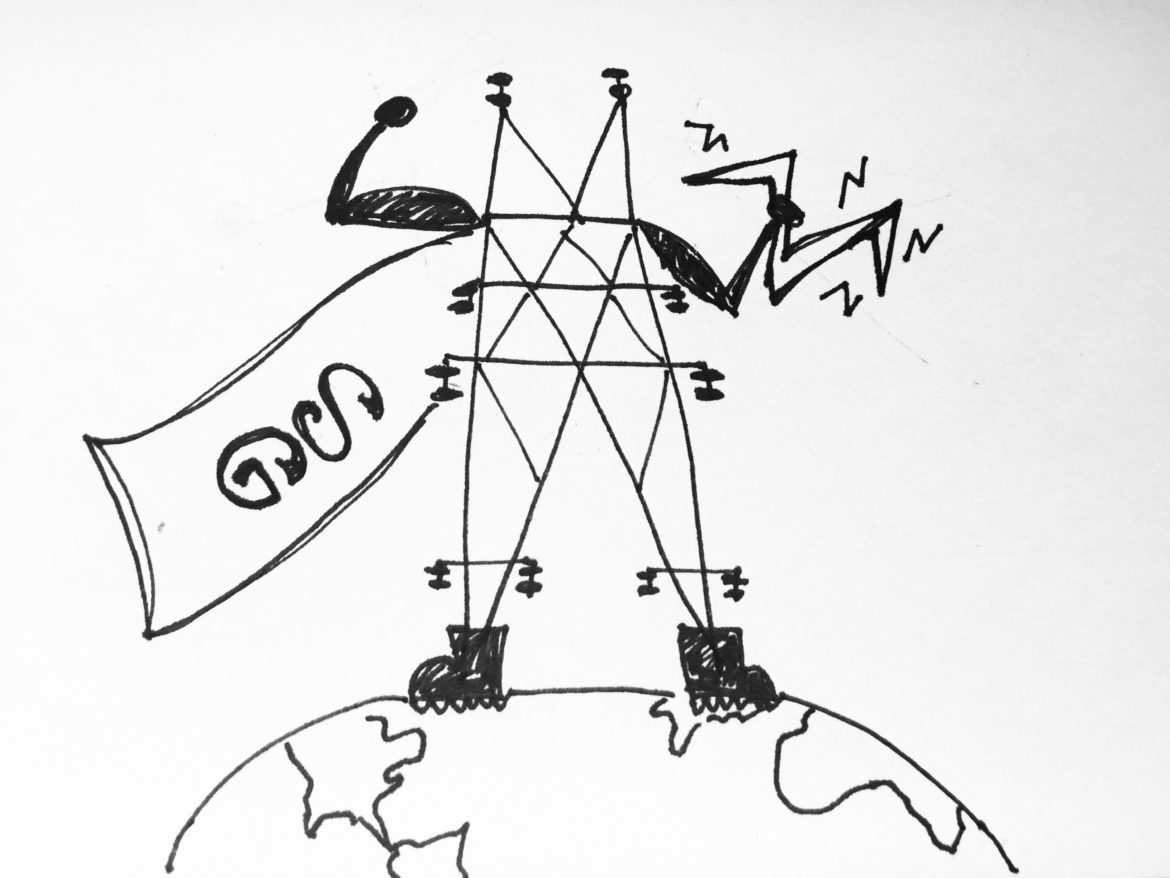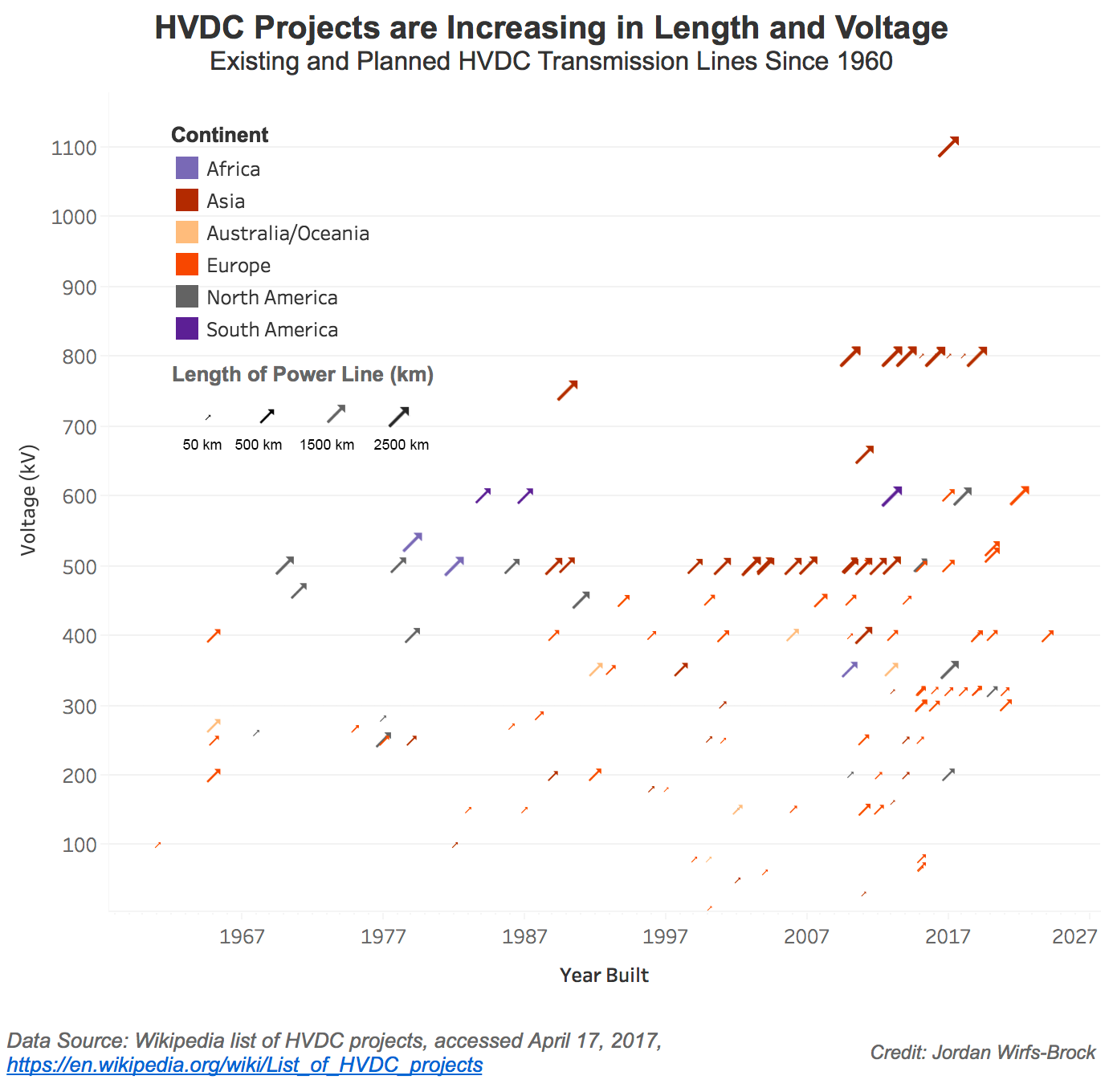Somewhere in the world, the sun and wind are always shining and blowing, and people are always using electricity. Wouldn’t it be nice if we could get renewable power from the windy and sunny places to the power hungry places?
That was presumably the thinking behind a question posed by an Inside Energy audience member:
Would transmission losses be too high to sustain an international green power electrical grid?
The short answer: Yes. An international power grid would sustain huge transmission losses and would therefore be too expensive to be feasible, right now. But in some situations, regional or continental grids do make financial sense and are already under development.
The longer answer: To fully understand this issue, we need to dive into the anatomy of the power grid, high-voltage transmission technology, and the politics of electric utilities…Here we go!
Wind and sun are abundant yet intermittent. Power grid operators can’t simply turn on the wind or sun whenever they need more power. Plus, we can’t save wind and solar power for later. (Not yet, that is: Storage is a topic for another day.)

The places with the most wind and sun aren’t the places with the biggest electricity appetites. On the left, high wind potential areas are shown reds and purples. On the right, densely populated areas are shown in darker blues. The maps are practically mirror images of each other. Sources: National Renewable Energy Laboratory (see full-sized map), U.S. Census Bureau (see full-sized map).
Thus, it would be great to get renewable power from the windy and sunny places to where it is needed.
Well, right now that’s difficult, because we don’t have any kind of global, coherent electricity infrastructure. Generally, each country operates its own power grid – or grids. Here in the U.S., we actually have three grids: Eastern, Western and Texas. Worldwide, there are hundreds of grids, and most of them aren’t hooked together.
But could we connect them?

Jordan Wirfs-Brock
Super Grid! Able to battle transmission losses and span continents in a single bound.
Here’s the dream: A global, interconnected supergrid that could take solar power from Australia to Singapore, or wind power from Saskatchewan to California. There’s a wrinkle in this plan, though. When electricity moves through power lines, some of it gets lost, dissipated as heat. (For more, check out our earlier article on this very topic.) The longer the power line, the bigger the losses.
Let’s say you want to connect Europe to North America. You’d have to run a power line more than 3,000 miles, buried under the Atlantic Ocean. Richard Brown, an engineering consultant who specializes in power systems, said a power line large enough to move electricity that far without losing it all would need to be huge, perhaps hundreds of feet wide. “Could you do it, yes you could,” said Brown. “But it’s not even close to economically making sense. There’s no benefit for this huge cost.”
Engineering, Brown said, is all about economics. And right now, at least, “There’s just cheaper ways to get green power than moving it all the way across the world.” Brown posed this alternative example: Somewhere sunny and remote, say the Gobi Desert, use the ample solar power to compress hydrogen. Then, put that compressed hydrogen on a boat and ship it somewhere populated, say New York. When it arrives, use the compressed hydrogen to generate electricity. That complicated, expensive, multi-step process would still be cheaper than building a massive power line to transmit electricity thousands of miles.
There are some technologies that can reduce transmission losses – like high-voltage direct current, or HVDC – and tip the economic scales back in the direction of power lines.
Let’s break HVDC down:
- Why high voltage (HV)? Transmission losses scale inversely with voltage, meaning the more voltage you can get in a power line, the lower the losses.
- Why direct current (DC)? Our power grid mostly runs on alternating current (see Inside Energy’s live rendition and radio story of the AC/DC battle for a refresher). But at high voltages, AC power lines generate magnetic fields that cause interference, resulting in extra losses. DC power lines don’t have this problem.

This graphic shows HVDC projects by the year they were built and their maximum voltage. The size of the markers indicate the length of the power lines and the color shows the location. In recent years, Asia and Europe have added many HVDC projects, while North America has lagged behind.
With HVDC, it’s economically feasible to build power lines that are hundreds of miles long. In the U.S., these types of lines are being built to connect, for example, the windy Oklahoma panhandle to Tennessee.
In fact, thanks to improvements in long-distance transmission technology, the entire Eastern U.S. is effectively linked up as one big grid. But there’s a catch: “Even though it’s already one grid, it’s not managed as one grid,” said Warren Powell, founder of the Princeton Laboratory for Energy Systems Analysis.
Even though the eastern U.S. is physically connected, operating decisions to balance power sources and needs, like where to send excess wind power and when to turn on back-up natural gas generators, are made at the local and state level, not for the eastern U.S. as a whole. Supergrids don’t just face technological barriers; they face logistical and political barriers as well. For example, Texas has had great success linking up windy western regions with eastern cities. But what worked well in Texas, which is not only a single grid but a single state, may be harder to implement across state lines.
“Each of these grid operators is like a little economy. They have all their own rules, they have their own grid economics,” said Powell. When you also throw in institutional inertia and cultural differences, “There’s no way you are going to get them to say hey, let’s join up.”
Yet some argue that the benefits of supergrids are so great, we can’t afford to give up on the dream. With respect to climate change, researcher Alexander MacDonald said, “Continental scale grids are the only technological way that we can solve this problem now.”
MacDonald, former director of NOAA’s Earth System Research Laboratory, was recently lead author on a study that analyzed various power grid configurations in 2030 – increased battery storage, long distance transmission, additional natural gas plants, etc. Based on projected costs, MacDonald’s model found the cheapest way to deliver power in the U.S. is to add wind and solar capacity and link up our country’s grid with HVDC power lines. This could, in theory, reduce power sector carbon dioxide emissions by 80 percent from 1990 levels, while keeping electricity prices at 2012 rates.
That type of infrastructure project would be a huge undertaking – akin to building the interstate highway system or a transcontinental railroad. “I’ve had lots of people tell me that the U.S. has gotten so sclerotic that we can’t build new things,” MacDonald.
Meanwhile, “China is proceeding ahead. They have a large number of HVDC lines they are building right now,” MacDonald said. “And on this one, we are getting left behind.”
Nonetheless, MacDonald remains an optimist. He’s old enough to remember when the U.S. interstate system was built, and thinks a continental grid in the U.S. will happen in his lifetime.
What’s Next
Lear more about supergrids and long-distance transmission:
- E&E News published a multi-part series on the idea of an American supergrid. Here’s part one.
- Clark Gellings lays out the case for a global supergrid in IEEE Spectrum.
- This report from the Department of Energy delves into the economics of HVDC networks.
- Where’s the longest HVDC transmission line in the world? Click here to find out.
- What’s your energy question? Submit it below, and it could become our next story.







